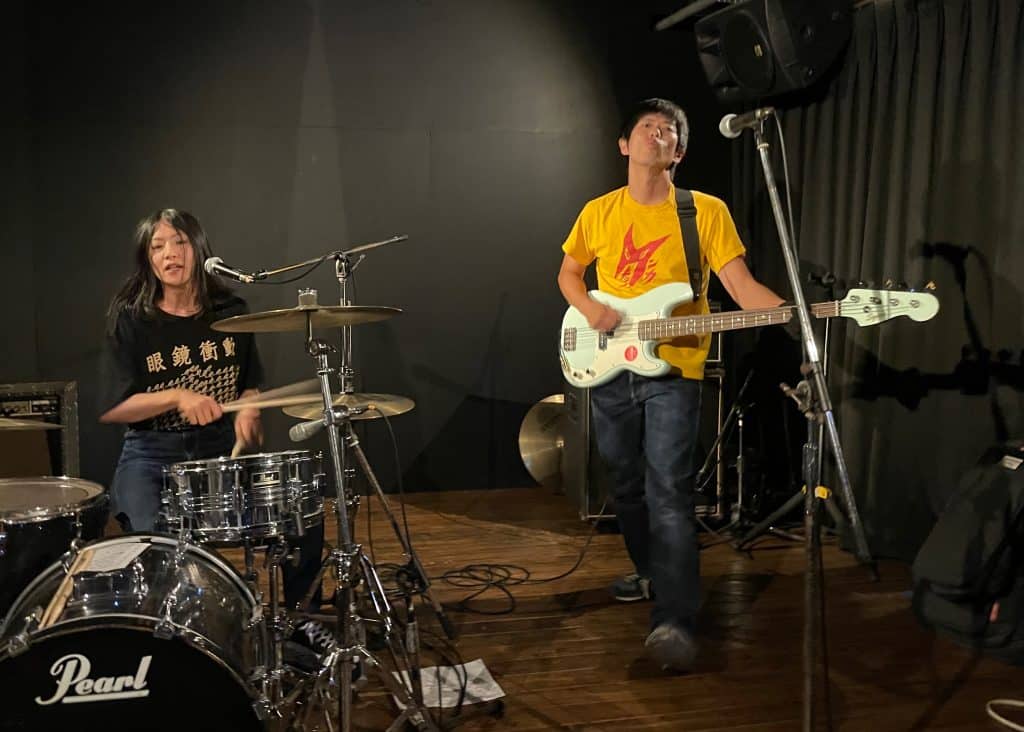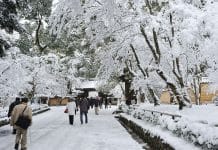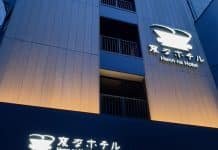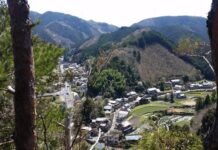Table of Contents
Introduction
Tsukamoto Station is stop on the Tokaido Main Line which connects the major cities of Tokyo and Kobe via Shizuoka, Nagoya, Kyoto and Osaka. It serves as a junction for the JR Kobe Line and the Fukuchiyama Line (JR Kobe Line). As a result you can get to Tsukamoto from Kyoto Station in 28 minutes, Kobe Station in 19 minutes, and Osaka Station in 4 minutes. Hell, if you were in Tokyo and felt the urge to have a drink in Tsukamoto for some reason, you could be there in 2 hours and 51 minutes. Although the station itself is in Nishi Yodogawa Ward, the actual Tsukamoto neighborhood is in Yodogawa Ward.

Local Charm: Old Shops and a Pomegranate Tree
But I’m not here to talk about trains. In the past couple of years I’ve truly fallen in love with the area around the station, one of the best kept secrets in Osaka. Although there around hundred shops in the vicinity, it still has a small town local feeling and everyone here seems to know each other. Everything is just minutes away on foot. You can explore the Kashiwazato Shopping Street, which was built in 1954 and has an old retro feel. I also love the fact that there is a pomegranate tree next to the station that bears fruit every year.


This article is not meant to be an extensive guide to Tsukamoto Station since I’ve only visited the area three times. Think of it as a starting point for your own adventures. I have found that bars restaurants here are cheaper than other parts of Osaka. For the sake of clarity, I didn’t include prices, which can change at a moment’s notice these days, but all of the places I visited are in the ¥1,000-¥3,000 range, depending on how much you order. Click on the Google Map address links for up to date prices.

Tsukamoto Eki Noren Machi 塚本駅のれん街 Under The Girders
The term ガード下 (pronounced gādo shita) literally means is “under the girders.” It refers to the space underneath elevated railroads or overpasses (made of steel girders) These underpasses are often home to gritty, nostalgic, urban yokocho alleys filled with tiny bars, cheap izakayas, smoky yakitori stalls, old ramen shops, and in some cases used record and book shops. Some well-known examples are Shimbashi in Tokyo, Tenma in Osaka and the area under the tracks between Sannomiya Station and Motomachi Stations in Kobe, all of which have a lively atmosphere that attracts commuters on their way home from work.

Tsukamoto Eki Noren Machi, located by the west exit of Tsukamoto Station, is only 50 meters long and consists of just 12 shops. This pales in comparison to the more famous yokocho mentioned above, but this lesser-known alley of bars and restaurants still has a great deal to offer. It is beloved among locals for its mix of Showa-era charm and newer restaurants that attract a younger crowd. In its own way, it’s a microcosm of Osaka night life crammed into a small space, which means you won’t have to travel far to the next place.
While it would be a blast to go barhopping at all 12 shops, we just visited two this time: Gaadoshita and Oruso.
Izakaya Gaadoshita 居酒屋がぁどした
Address: 3-1-41 Kashiwazato, Nishiyodogawa-ku, Osaka-shi, Osaka 532-0026. Japan. Tel:06-6477-7803. Open: 17:00-12:00. Closed: Tues. Instagram.
It’s only fitting that a restaurant under the tracks of Tsukamoto Station would be simply named Gādoshita, albeit with the slightly different spelling in hiragana as がぁどした (Gaadoshita). The restaurant, which is run by a father and daughter, came to my attention years ago in a magazine, and I had always planned to stop by, but then the pandemic hit. While many small izakaya had to close due to a lack of business, the owners of Gaadoshita used social media to announce that their most popular items would still be available for takeout in bento boxes. Although I had never set foot in their establishment, I found myself rooting for them. They just seemed like nice, hardworking people struggling to keep their business afloat during hard times.

When I finally made it to Gaadoshita, it was everything I for in a local spot, with just the right amount of clutter and charm. Handwritten menu items on scraps of recycled paper, Hanshin Tigers paraphernalia, faded posters and fliers covering the walls, and stickers plasted on the oshibori towel warmer. Bottle keeps from regulars lined the shelves, and under the counter a cluster of five to seven kashikasa (貸し傘) umbrellas lent out to customers on a rainy day stood ready. There was even an old black rotary telephone from the Showa era in working condition that was still in use.
Meeting Oyassan

I was able to meet the owner, known to everyone as “Oyassan.” He was just as warm and welcoming as he appears in the photos. When I told him that I lived on the other side of Osaka, both he and his daughter were genuinely surprised that I had spent over an hour riding the trains just to visit their restaurant. Truth be told, I was was actually headed see a rock show at Elavaty later that evening (see below), but I couldn’t resist stopping by. Despite its Showa-era look, Oyassan told me he opened Gaadoshita in 2007, which means that the shop has been around for nearly two decades. To me, that seems like yesterday.

Nagoya Fried Chicken
Gaadoshita has a wide-variety of homemade Japanese, Chinese and Western-style dishes, with specialities that include motsu nabe (hot pot made with chicken or pork offal and assorted vegetables), gyoza and harumaki spring rolls. I spot Nagoya-style fried chicken on the menu, traditionally made with chicken wings (tebasaki) that are deep-fried twice, coated in a sweet-savory glaze of soy sauce, mirin, sake and sugar, and then finished with a generous sprinkle of pepper and sesame seeds.
Gaadoshita, however, puts a twist on the classic by using boneless chicken thighs instead of wings. It’s a variation I’ve never tried before, but the result was juicy and packed with flavor. (You can find Nagoya chicken wings at Yama-chan in Osaka)

Chuka Reimen
Chuka Reimen (Chinese-style cold noodles) is the perfect dish for the summmer heat, but I can enjoy it all year round. After eating the Nagoya-style chicken I was in the mood for a dish with fresh vegetables. The reimen served at Gaadoshita packs in fresh tomato slices and julienned cucumbers that taste as though went from farm to table that very morning. Everything in this dish is in top form, from the shredded omelet to the mouth waters slices of pork cooked to perfection. The chilled noodles were chewy and delicious in the tangy sauce. There are many items I want to try but I’m glad I picked two winners on my first visit.

Next Visit: Meatballs!
There’s always that one dish you find out about after visiting a local spot. In my case, I regret not ordering the meatballs at Gaadoshita. They look absolutely fantastic, much better than the overpriced Swedish meatballs I had at Ikea last month. Here, they’re sharing a plate with steamed kabocha squash, which also looks quite tasty. I definitely wouldn’t mind making another trip to Tsukamoto to try this combo. Next time I’ll round up some drinking buddies and sample more of the menu cowboy-style!

Oruso: Gourmet Izakaya おるそ塚本
Address: 3-1-41 Kashiwasato, Nishiyodogawa-ku, Osaka-shi, 532-0026. Tel:06-7709-5090. Open:16:00-24:00 Website. Instagram
My wife and I discovered this wonderful izakaya by accident. We had tickets to see The Takosan at Howlin’ Bar. Who wants to get filled up before a concert? So we walked up and down Eki Noren Machi a few times in search of a light meal. We found ourselves lingering outside of Oruso because the food photos on display looked so enticing. Since it was what older married couples refer to as a “date night,” I checked a few reviews on Tabelog just to be sure. The comments were overwhelmingly positive—one even said, “Please give me an endless stomach so I can eat all this delicious food!” (たくさん料理を食べられる無限の胃袋をください!)

Meeting The Bear
When you enter the shop, the first thing you’ll notice is a giant prosciutto ham, that is proudly displayed on a wooden stand. The Japanese word for bear is kuma, and the owner-chef of Oruso goes by Kuma-san. He earned the nickname thanks to his big burly build and bear-like presence. After honing his skills working at Spanish, Italian, and other types eateries across Kansai, Kuma-san returned to his hometown to open a place of his own.

The Grand Menu and All-You-Can-Drink Options
The menu at Oroso changes daily but the most popular items can still be ordered from the”grand menu.” This includes freshly-cut Jamon Serrano, Octopus Carpaccio, “Kuma’s Special Omelet”, four kinds of pasta and Fried Camembert Cheese, which is served with a seasonal jam. One of the best deals has to be the the Wagyu Tataki, which is very reasonably priced under 1,000 yen.

Although the shop seems small from the outside and the counter only seats 12, I was surprised to find that the second floor has four tables that can accommodate 20 people. For groups of three or more, there is a three-hour all-you-can-drink course starting at ¥4,000, which is perfect for an enkai-style party for friends or co-workers.
Shrimp Fritters
It was time to order. Before entering the shop, I had read a newspaper write-up proudly displayed outside that raved about the octopus and shrimp fritters which are served with your choice of seven homemade tartar sauces. Kuma-san learned to create the fritters while working at an izakaya. He blends eggs whites and heavy cream into the batter to create a fluffy texture. We decided to go with the shrimp. I loved this dish at first bite and the crunch was audible. We’ll be sure to try the octopus fritter on our next visit.

Chikuwa Isobe Age
Our next dish was Chikuwa Isobe-age. This dish always takes a bit of explaining if you haven’t tried it. Isobe means seashore, because seaweed is an essential ingredient that gives it an umami flavor and an aroma that smells like the ocean. Chikuwa are fish paste tubes which are fried in aoni butter. This is a popular dish in Osaka, but there are times when it is too oily, too dry or too soggy. We had nothing to worry about, because they were made to perfection.

Ebi Matsuri Shrimp Festival Special Menu
My wife M was the one who ordered the dishes you see in the photo below, and I devoured my share like a greedy beast. As a result, I honestly have no idea what I ate. Sure I could ask her, but I already know how that would go: “How am I supposed to remember? You should have written it down instead of ordering that second beer!”

So instead I spent nearly an hour carefully combing through every single item on the menu, trying to match the photos. No Luck. Then it hit me-what is this, 1975? I could just send the photo to their Instagram account and ask. No joke, I got a reply in 45 seconds. “Hello! These dishes were from the ‘Ebi Matsuri’ (Shrimp Festival) event 😄 They are: stir-fried shrimp with cashew nuts, shrimp and lotus root with mayonnaise, and shrimp dumplings with sweet chili sauce ✨”
These descriptions awakened the muscle memory of my taste buds. I felt like eating the entire meal all over again.
Cafe B.P.M. 비피엠
Address: 2-21-5 Tsukamoto, Yodogawa-ku, Osaka-shi, 532-0026. Tel: 06-6195-9972. Open: 9:00-18:00. Website. Instagram
You don’t have to book a flight to Seoul anymore to experience the stylish cafes you’ve seen in popular Korean dramas and movies. There are times when I’ll be engrossed in a Korean psychological thriller on Netflix, only to lose focus when the characters wander into some impossibly chic cafe, casually sipping lattes and digging into exquisite desserts. Me? I have to pause the movie because I am distracted by a slice of cheese cake topped with oreos and chocolate syrup that looks like it belongs in an art gallery. I think many Japanese fans feel the exact same way, because their interest in Korean pop culture has helped fuel the rise of these ultra-modern Korean-owned cafes in major cities across Japan, including a fair number in Osaka.

So, getting back to the story. After leaving Eki Noren Machi, we had about 45 minutes to kill before the first band went on. We walked under the tracks and wandered around the neighborhood, trying not to stray too far from the venue. That’s when we stumbled upon Cafe B.P.M., an incredibly-stylish Korean cafe tucked on a sleepy corner. Our first reaction was shock and awe when we saw the gorgeous interior through window. But then we noticed the shop closes at 19:30. There wouldn’t be time to come back after the show, so we decided to go inside for a quick coffee and maybe a bit of dessert.
Korean Minimalism Design
BPM’s interior is a perfect example of Korean minimalism done right. White, cylindrical stools and tables are neatly arranged around a path of rectangular stepping stones laid over black pebbles, which reminded me of a rock garden at a zen temple. The decor consists of dry branches and potted plants and a few small wooden crates to hold belongings. The walls are also white and completely bare, without any artwork, posters or fliers advertising events. The cafe’s name, spelled out in bold black Korean characters (비피엠 – “BPM”) is displayed on a circular light fixture centered on the back wall, emitting a soft, yellowish hue that complements the serene atmosphere.

A white bookshelf on the left side contains carefully curated titles in multiple languages including Urbanlike, an elaborately designed Korean lifestyle magazine, The Lonely Ones by photographer Gus Powell*, and an impressive hardcover artbook containing the work of German artist Albert Oehlen*. The pink Korean books is 연애의 기억법 (The Memory of Love) by Lee Woo-il, Kim Hye-nam.

Update: Turns out this old man was completely fooled. The books are actually replicas, hollow on the inside and used mostly as photo props. Apparently, this is a trend in Korea. I knew something was off when I spotted the Oehlen book, since it’s rare and sells for $2,500! Who would have guessed it pairs so well with an Oscar the Grouch cupcake? On the bright side, I also discovered that Cafe BPM serves a hearty breakfast. Ironically, I’ve now found myself genuinely interested Gus Powell and Albert Ohlen, all thanks to a stack of fake books. One has to wonder if authors are paid royalties for their fake books?


S’Mores
A few years ago a Japanese English teacher asked me to explain S’mores to her students because there was a reference to them in the junior high school textbook. I don’t think I did a great job selling the idea of roasting marshmallows and making a sandwich with chocolate and graham crackers. It just sounded too messy and dry cleaning in Japan isn’t cheap. Leave it to Korean cafe innovation to take this 100-year old North American campfire treat and make it both palatable and trendy for Japanese consumers.

The S’mores sold at BPM must be their original menu idea, because I couldn’t find any evidence of a S’mores trend in Korea online. Here, the melted marshmallow is placed between a good-sized homemade-style cookie and your choice of a smaller Oreo or Lotus cookie on top. It’s incredibly simple, yet creative and full of flavor. Best of all, there’s no sticky mess since the chocolate chips can be baked right into the cookies.

My wife can be seen in the photo above doing the “marshmallow lift” which is based on the “men lift” (麺リフト), the technique Japanese ramen fans use to show their followers the quality of the noodles. Actually, I don’t think she meant to do this, the marshmallows were just very elastic. I would definitely order these S’mores again.
Seasonal Cakes and Cafe Origin
I don’t know about you, but If I had the skills to make a watermelon cake that actually resembled a slice of watermelon, I’d be showing it off at every birthday, anniversary and retirement party just to soak up the compliments. The owner of BPM, though, seems to prefer staying out of the spotlight. Unlike other business owners who actively use social media to promote themselves, there’s almost no personal information about him online. That’s why I felt it was important to respect his privacy and not pester him with a bunch of questions during our visit. I like that the cafe has a bit of mystery around it.

I did find a very short interview online. The owner said that started working part time in a cafe while he was a university student in Korea. At one point he considered going to culinary school in France, but an acquaintance convinced him to study in Japan. While in Japan, he met his now-wife and eventually decided to open a cafe in her hometown of Tsukamoto.

The couple named their cafe B.P.M.,which stands for beats per minute because they wanted it to be the kind of place that gets your heart racing the moment you walk in. To keep that energy going, they regularly update the menu with new monthly and seasonal items that keep customers coming back. I definitely need to try the croffle, the crispy, buttery and golden croissant-waffle hybrid that was popularized in South Korea and spread throughout the world.
A Place for Photography
I imagine that a lot of people come into this cafe hoping to feel like they’ve been transported into Korea and the owners have worked hard to make that happen. The signs are all in Korean and English and not a bit of Japanese in sight (except on the menus). There’s a slogan on the main that says, 오늘도 커피 마시고 힘내자” (“Let’s drink coffee and cheer up today too.”) Overhead, a mix of regular and vintage-style filament bulbs gives off a warm, cozy glow. It’s the perfect lighting for taking Instagram photos and capturing that Korean-drama inspired stylish cafe vibe. The owners even change the decor to match the seasons.

Howlin’ Bar: Blues Bar and Live House ハウリンバー
Address: Ishikawa Bldg. 2F, 2-1-19 Kashiwasato, Nishiyodogawa-ku, Osaka, 555-0022. Tel: 06-4808-2212. Open: 19:00-4:00. Closed: Wed. Facebook
Years ago I overheard someone at a show mention a bar in Osaka named after legendary bluesman Howlin’ Wolf. The name stuck with me, and after a a bit of digging, I found out the place did indeed exist and was located near Tsukamoto Station. Howlin’ Bar is a shot bar that hosts live performances, mostly blues and jazz musicians, but with a fair share of rock bands, and even the occasional punk rock band.

Over time, it has built up a loyal crowd of regulars who keep coming back, not just for the music but for the bar itself. In many ways, this worn-in venue with its classic dive bar atmosphere is as much of a draw as the live shows. Even on nights without a performance, music fans often drop in to enjoy a drink and a chat while listening to music on CDs.
The Takosan: Live at Howlin’ Bar
The Takosan is a soul, blues and funk band formed by singer Yashiro Ando, who became obsessed with artists such as James Brown and Rufus Thomas after seeing The Blues Brothers movie in the sixth grade. He formed the Tako-san with friends from a part-time job in 1993. Over the years, the band has developed a cult following all over Japan with their infectious live show. The band, which has released six albums, has played the Fuji Rock Festival three times. One appearance got the crowd so worked up that they demanded three encores and the show had to be stopped. Newcomers should start by watching videos for the singles “Kakkoii Kara Daijobu” and “Omame Pon Pon Pon.”

When I heard that the Takosan would be playing one of their last shows at Howlin’ Bar before going on indefinate hiatus, I knew I had to make a special trip to Tsukamoto to see them while I still could. Perhaps aware that this would be their last show at Howlin’ Bar for some time, the band ripped through an electrifying set of their greatest hits.The seating capacity of Howling Bar is around 40 people, but the band played as though they were in front of 40,000 fans.

By the end of the show singer Ando was covered in sweat and sprayed cooling spray all over his body that created a mist-like effect, which was must cheaper than using smoke machines. Ando currently plays slide guitar in The Ammonians, a four-piece blues band. They often play at Rhythm & Kushikatsu Agotta, a restaurant in Higashi Shinsaibashi, which is owned Ando and his wife Haruko, a singer. The Ammonians have a show there on June 21st with two other bands. Check their Twitter page for more upcoming events.
Opening Act: UCC
UCC kicked off the show with a highly entertaining set of melodic punk rock that completely knocked me out. I bought their CD-R minutes after the final note was played. Although they’ve shared the stage with bands such as Gasoline and Masatsu Genin, finding anything about them online has been suprisingly difficult. It doesn’t help that “UCC” is oalso the name of one of Japan’s most popular coffee brands in Japan. Imagine trying to Google a band called “Maxwell House,” you see what I mean?

After some internet sleuthing, I found that the band’s initials stand for “Urushihara Country Club,” but searching for that online gets you zilch, nada, nothing. On a positive note, I managed to track down two of the members on Instagram and discovered that they own local business nearby. Vocalist Ucchan runs a bar called Fly Over, while bassist Mon-Tack owns a stylish takoyaki shop called Orank. Tsukamoto must be a very tight community, because Ucchan and Mon-Tack are involved in side projects with other bar and restaurant owners, and by going down the rabbit hole, I was able to compile enough interesting spots for a follow up article on Tsukamoto night life.
Upcoming Shows in Osaka: Hokage (June 25).
Falafel Time: Middle Eastern and Vegan Oasis ファラッフェルタイム
Address: 3-12-10 Kashiwasato, Nishiyodogawa-ku, Osaka, 555-0024. Tel:080-2002-1818. Open: Mon-Thur 11:00-20:00. Sat: 17:30-23:00. Closed: Fri. Sun. Instagram
Falafel Time is a Israeli restaurant with plenty options for vegans, owned by a friendly Israeli-Japanese husband and wife. It’s famous all over Kansai for its authentic taste and large portions. We were famished after the show at Howlin’ Bar, so we were overjoyed to discover that Falafel Time was just a short stroll away. I had wanted to try their food since reading rave reviews when they opened in 2020. The restaurant uses Halal chicken for their shawarma and other meat dishes.

Chicken Shawarma Roll
I went for the chicken shawarma roll, which is listed as “kebab roll” on the Japanese menu since the word shawarma hasn’t really caught on here yet. Shawarma in Japan can be hit or miss. I’ll sometimes grab one from a food truck or a stall at an international fair, but more often than not, the flavor has been watered down to suit local tastes. Some are even topped with French dressing. I get it. Adapting your food for a broader market often makes business sense. But sometimes, you just want the real thing. And man, did Falafel Time deliver. The roll was packed with juicy, well-seasoned chicken bursting with flavor. I was in heaven!

Falafel Roll
My wife ordered the falafel roll, which was huge and wrapped in tin foil. It was split in half to make it easier to eat, but seriously, this looked like two orders. In the end, my wife was unable to finish it because she wanted to save room for the hummus —her loss and my gain. I mean, who in their right mind could turn down a delicious falafel packed with veggies, especially in Japan, where they’re not exactly easy to find. Some people prefer falafel in pita bread, which I totally understand, but I got to say, it’s nice to eat them burrito-style so they don’t fall apart on you.

Humus, Baba Ghanoush, Sabich, Shakshouka, Pizza and More
We enjoyed our meal at Falafel Time so much that we went back a few months later and ordered the exact same thing! Next time there is no way we are leaving without trying the hummus, pita and egg plate (vegans can order it with eggplant). I don’t think I’ve ever had baba ghanoush in Japan. I believe you can order it with pita or Malawach (Yememite flatbread). Sabich was created Iraqi Jews in Israel in the 1960s. “It’s a sandwich of pita or laffa bread stuffed with hardboiled eggs, chopped salad, parsely, amba and tahini sauce.” (Source: Wikipedia). Here, they serve in in a tortilla roll with French fries inside.

Shakshouka is a traditional Maghrebi dish featuring eggs poached in a rich sauce of tomatoes, olive oil, peppers, onion and a flavorful blend of spices. Vegans will be happy to know that an eggplant substitution makes this dish entirely plant based. The Mix Plate of Chicken Shwarama, Hummus, Fried, Eggplant and Pita is perfect way to sample the most popular offerings in one sitting. The pizza, which appears to be made on their pita bread and topped with chicken shwarama, looks fantastic. However, it’s unclear whether its a regular menu item, so it’s best to contact the restaurant in advance. For those unable make a trip to Tsukamoto, you can order select menu items from Uber Eats.
Elavaty: Coffee Shop and Live House 塚本エレバティ
Address: 2-21-4 Tsukamoto, Yodogawa-ku, Osaka-shi, 532-0026. Tel N/A. Open (Cafe) 13:00-18:00. Sat/Sun for events only Closed: Thur. Instagram
During the day Elavaty is a laid back coffee shop that serves homemade cakes and pudding. After 6 P.M. the space is can be rented out for live shows, DJ events, photography exhibitions and other gatherings. Monthly in-house events include Open Turntable, in which customers can bring their own vinyl and DJ in rotation for 20 minutes at a time. No experience necessary. The next one is on June 6th, starting at 20:00. Since the venue is located under the tracks, there is no need to worry about bothering the neighbors with excessive noise.

DJ Masa: Rock ‘N Roll License
I went to Elavaty for the first time to see three rock/punk duo’s perform: Sister Paul, The Yayako and 50/50s. The show was organized by by DJ Masa under the banner of Rock and Roll License. It was a great opportunity to see some bands at a somewhat obscure venue that doesn’t get many rock or punk shows. Tickets were only ¥2,000 and the drinks were reasonably priced.

DJ Masa got the party started by spinning an impressive collection of 7″ singles from a wide range of artists from Elvis Presley to The Ripoffs that included some deep cuts. In between sets, I kept busy snapping photos of one fantastic record after another by The Fist, Dave Phillips and The Hot Rod Gang, Keen Monkey Work, The Gimmies, Sham 69 and The Saints. I wore a Buzzcocks t-shirt to the show, which Masa noticed when I walked in. He welcomed me to the venue by spinning three songs from the band including “Ever Fallen In Love (With Someone You Shouldn’t’ve).” Check DJ Masa’s Instagram for upcoming events.
Sister Paul
Sister Paul is an androgynous male/female bass (Susumu) and drum (Mackii) duo from Tokyo who combine 70s David Bowie, Lou Reed, Sparks and glam rock with the 80s New Wave sounds of The Cars and Talking Heads. Their original songs such as “Ride My Motorcycle” are fantastic but they also perform killer versions of “Just What I Needed” and “Psycho Killer”. Sister Paul has toured as the back up band in Japan for Richard Strange of 70s UK band Doctors of Madness.

After the show, I purchased their CD Howl! Howl! released on Captain Trip Records in 2001. Man, they really should have been much bigger abroad. The song My Silver Raincoat is a real standout. You can catch Sister Paul on their first-ever tour of the US with one-man tribute band The Ramone this summer from June 28 to July 12th in select cities.
50/50s
50/50s, a duo from Osaka kicked off the show with a bang. Made up of Yoheii Sozaki (guitar/vocals) and Naruha (drums/vocals), combine garage rock and blues with a strong pop sensibilities. Although the band has been around since 2015, the addition of Naruha on drums have taken their live shows to the next level with her powerful and precise drumming. “Holiday,” the standout side of their single released by German label Topsy Turvy records has impressive vocals and catchy hooks to die for. This was my third time seeing 50/50s in Osaka and they were a perfect fit for this venue. I have to give props to Elevaty for having such incredible, crisp, clear sound for a part-time live house.
The 50/50s have two upcoming shows in Osaka: Live Bar Hash near Shonai Station (June 14th) and Umeda Hard Rain (June 24th).

The Yayako
The Yayako are a bass and drums duo influence by The Stooges, Guitar Wolf and King Brothers. Years ago. Eric Friedl of The Oblivians once described a certain type of garage band as having “more love than skill.” I think the Yayako are a prime example of this when they started out, because they played each show with all heart, regardless of the venue or size of the crowd. When I saw this show they had just gotten back from a small tour of the U.S., and I could tell that this must have been an amazing experience for them because they tore the roof off Elavaty with a ferocious set. Now they have as much skill as heart!
Upcoming shows in Osaka: Hokage (June 18), Umeda Hard Rain (June 21). Check Twitter for more info.

Best View in The House
One thing I really appreciate about Elavaty is the a small upstairs area with with tables for food and drinks. These days, I find that I don’t quite have the stamina to stand for an entire show, so it was nice to step away from the crowd and plop down into a comfortable chair with a birds eye view of the stage. I’ve never had the experience of sitting in box seats at the opera, so this might be the closest I’ll ever get.

Documentary on The Tsukamoto Rock Scene
Here’s our very own exclusive documentary on the Tsukamoto rock scene featuring all the bands in this article: 1. The Takosan 2. UCC 3. Sister Paul 4. DJ Masa 5.50/50s 6.The Yayako. Shot raw and unedited with no overdubs.




















